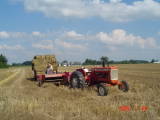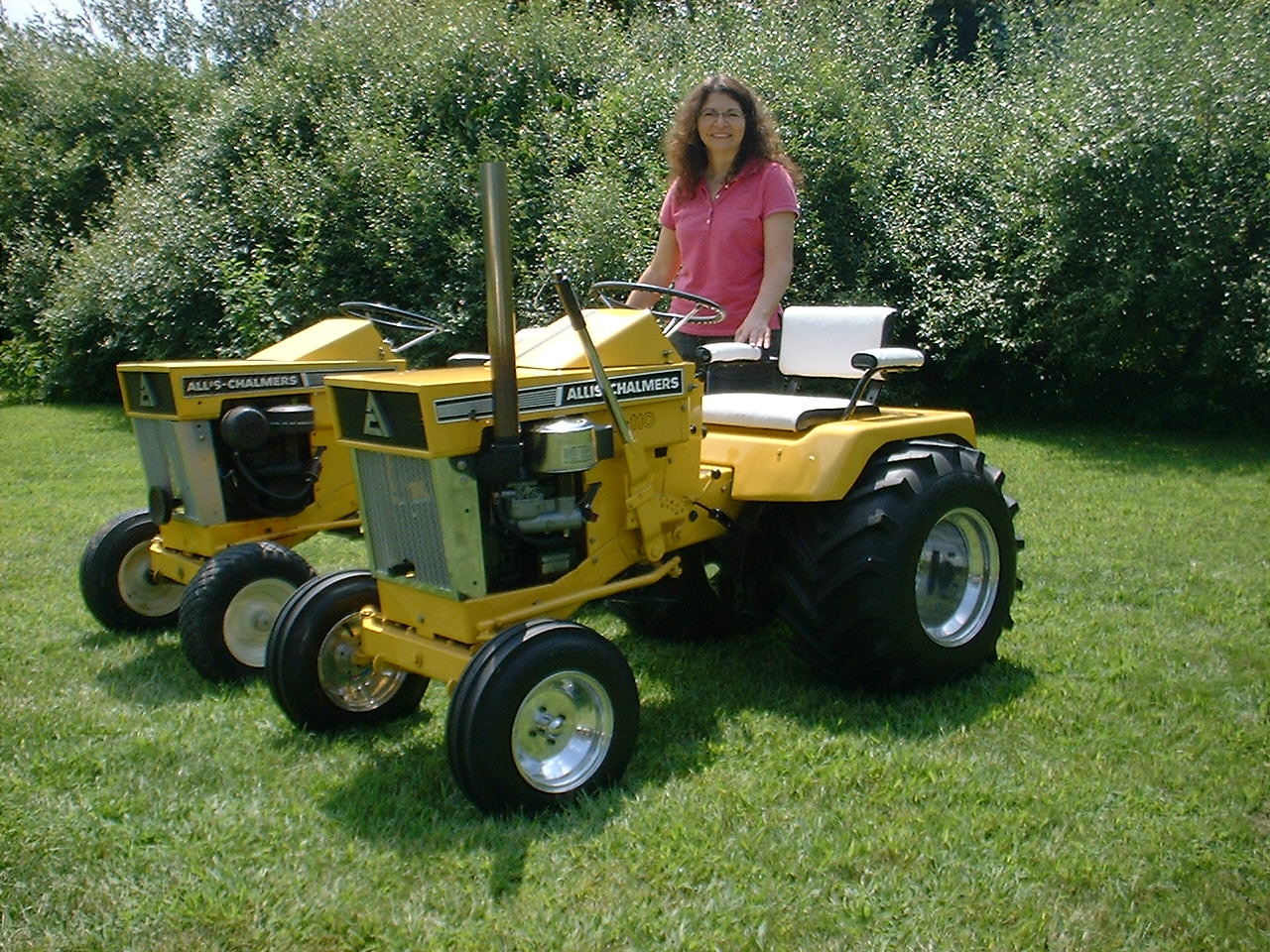| Author |
 Topic Search Topic Search  Topic Options Topic Options
|
paulinkansas 
Bronze Level

Joined: 30 Nov 2009
Location: Kansas
Points: 45
|
 Post Options Post Options
 Thanks(0) Thanks(0)
 Quote Quote  Reply Reply
 Topic: Carb is overflowing with gas Topic: Carb is overflowing with gas
Posted: 06 Jan 2011 at 5:37am |
This is a Marvel Schebler TSX 871 on a D17. I rebuilt the carb about a year ago with one of the $25 kits (new jets, gaskets, float valve, etc). The float valve does not stop the flow of fuel to the bowl. If I forget to close the sediment bowl when not using the tractor, the crank case will fill with gas. I've put the proper .25 inch gap between the gasket surface and the top of the float. Also, in the metal tab portion of the float, there was a little dimple from the shut off needle. I filled the dimple with solder and filed it flat. I've removed the needle from the valve and flushed the fuel passageway out. Finally, I put the carb back on the manifold, attached the fuel line, and turned on the gas at the sediment bowl. After 30 seconds, fuel was dripping out of the air inlet.
What could be the problem? Is it the float valve?
|
 |
|
Sponsored Links
|
|
 |
DonDittmar 
Orange Level


Joined: 15 Sep 2009
Location: MIllersburg, MI
Points: 2516
|
 Post Options Post Options
 Thanks(0) Thanks(0)
 Quote Quote  Reply Reply
 Posted: 06 Jan 2011 at 5:48am Posted: 06 Jan 2011 at 5:48am |
|
Almost gotta be the float. Sometimes the needle needs to seat in the seat beofre it seals off. I ran into this with dads D17, couldn't keep gas from runnin out of it if it was shut off. Finally got tired of messing with it and over time from use the needle seated itself. Also make sure the float doesn't have any holes in it and will actually "float"
|
|
Experience is a fancy name for past mistakes. "Great moments are born from great opportunity"
1968 D15D,1962 D19D
Also 1965 Cub Loboy and 1958 JD 720 Diesel Pony Start
|
 |
Dick L 
Orange Level


Joined: 12 Sep 2009
Location: Edon Ohio
Points: 5087
|
 Post Options Post Options
 Thanks(0) Thanks(0)
 Quote Quote  Reply Reply
 Posted: 06 Jan 2011 at 6:22am Posted: 06 Jan 2011 at 6:22am |
|
I would guess that the needle has the rubber/plastic tip. If you get one that was not (packed out) when being made (material injected into the tip mold) it will never seal.
When they first started making the needle with the plastic tips I had about half of them fail. (about six that failed) back about ten years. After a few years not many of the ones that didn't fail now leak. I shut off the gas to all my tractors when I shut them down now.
Most I let run the gas out and die then shut off the switch.
I have found that they can hold most of the time but when I decide to trust one it seems to have an empty tank when I need to use it.
I have eight tractors that I use from time to time but set most of the time.
|
 |
jaybmiller 
Orange Level Access

Joined: 12 Sep 2009
Location: Greensville,Ont
Points: 24697
|
 Post Options Post Options
 Thanks(0) Thanks(0)
 Quote Quote  Reply Reply
 Posted: 06 Jan 2011 at 6:36am Posted: 06 Jan 2011 at 6:36am |
Quick(?) check for a bad float is to take it out and 'rattle' it near your ear. If it sloshes,it has a pinhole and is filling with gas,which will lower it away from the needle valve seat and gas will flow forever. I've repaired them by gently heating them with a heat gun to force evaporate the gas out. Gently ! Once you get the right heat a 'volcano plume' of gas vapours shows you where the pinhole is. When it stops, clean that area good with fine sandpaper and solder up the hole.Clean off the flux then lightly heat it up and hold in a pot of water. No bubbles means a job well done.
|
|
3 D-14s,A-C forklift, B-112
Kubota BX23S lil' TOOT( The Other Orange Tractor)
Never burn your bridges, unless you can walk on water
|
 |
Boshears Carb & Mag 
Bronze Level

Joined: 04 Jan 2011
Location: Bloomington IN
Points: 7
|
 Post Options Post Options
 Thanks(0) Thanks(0)
 Quote Quote  Reply Reply
 Posted: 06 Jan 2011 at 8:22am Posted: 06 Jan 2011 at 8:22am |
More than likely the needle is viton tipped, metal needles do require a few hours of field service to get seated properly. I have seen many carbs that the viton tipped needles don't seal properly after a little use, they are fine while running but will get a slow leak when shut off. Certain floats are prone to cracking due to the shape when the halves of the pontoons are stamped. If you add to much solder your float will become to heavy. The rattle test is a good one as long as you don't hear a small bead of solder inside. I test floats by putting them in the freezer overnight then put them in pretty hot water the next morning and watch for bubbles. I always install a new float in my rebuilds , it saves a lot of headaches on down the road. I have been installing a small ball valve in the fuel line on my tractors. It is easy to flip a 1/4 turn ball valve on and off and not have to worry about the packing leaking on a sediment bowl that is hard to reach on some machines. I have seen the bowl vent on a carb get plugged up and cause a similar problem.
|
 |
Brian Jasper co. Ia 
Orange Level

Joined: 11 Sep 2009
Location: Prairie City Ia
Points: 10508
|
 Post Options Post Options
 Thanks(0) Thanks(0)
 Quote Quote  Reply Reply
 Posted: 06 Jan 2011 at 10:59am Posted: 06 Jan 2011 at 10:59am |
|
Another thought is you could have debris holding it open. I ran into that on my CA. Always had to shut the fuel off and always had to fiddle with the carb or take it apart and blow out the jets. It had a new sediment bowl, but I reused the old steel line to the carb. The vibration from the engine running was loosening little bits of junk and they would plug up the carb and/or hold the float valve open. I fabbed up a new line and haven't been inside that carb going on 15 years now.
|
|
"Any man who thinks he can be happy and prosperous by letting the government take care of him better take a closer look at the American Indian." Henry Ford
|
 |
Gerald J. 
Orange Level

Joined: 12 Sep 2009
Location: Hamilton Co, IA
Points: 5636
|
 Post Options Post Options
 Thanks(0) Thanks(0)
 Quote Quote  Reply Reply
 Posted: 06 Jan 2011 at 11:54am Posted: 06 Jan 2011 at 11:54am |
|
When I work on a carburetor, I blow into the gas inlet and gently lift the float to see if it closes off the wind pressure I can blow. If it doesn't I look about a different set of needle and seat.
Gerald J.
|
 |
BobHnwO 
Orange Level


Joined: 16 Sep 2009
Location: Jenera Ohio
Points: 693
|
 Post Options Post Options
 Thanks(0) Thanks(0)
 Quote Quote  Reply Reply
 Posted: 06 Jan 2011 at 12:05pm Posted: 06 Jan 2011 at 12:05pm |
|
The smallest speck of dirt coming out of the tank can cause float valve to leak.
|
|
Why do today what you can put off til tomorrow.
|
 |
stu(ON) 
Orange Level

Joined: 12 Sep 2009
Points: 377
|
 Post Options Post Options
 Thanks(0) Thanks(0)
 Quote Quote  Reply Reply
 Posted: 06 Jan 2011 at 3:17pm Posted: 06 Jan 2011 at 3:17pm |
|
Try opening up the float adjustment a tad. The spec was set for original thickness of bowl gasket and original density of gasoline. Things change over 50 years. Gasket thickness may be different. Gas certainly has changed as it has no lead, but does have lower boiling volatiles in winter and likely alcohol any old time. This doesn't lift a float as well. If it seals the flow at the seat you're probably good unless you find the engine really starved for fuel under load.
|
 |
daveingreenbay 
Silver Level


Joined: 09 Oct 2009
Location: Green Bay
Points: 268
|
 Post Options Post Options
 Thanks(0) Thanks(0)
 Quote Quote  Reply Reply
 Posted: 06 Jan 2011 at 7:32pm Posted: 06 Jan 2011 at 7:32pm |
|
Had a carb professionally rebuilt, put it on and it dripped gas, tried several used needle/seat combinations, no luck. Finally figured out the new float was rubbing the inside of the carb body. Installed a good used float. Problem went away. HTH
|
 |
Chalmersbob 
Orange Level

Joined: 11 Sep 2009
Location: Pennsylvania
Points: 2122
|
 Post Options Post Options
 Thanks(0) Thanks(0)
 Quote Quote  Reply Reply
 Posted: 06 Jan 2011 at 8:40pm Posted: 06 Jan 2011 at 8:40pm |
Paul, I interested in knowing how the crankcase will fill up with gas with an updraft carb.
I could see how it can happen on a downdraft carb. Thanks
Bob
|
 |
Bill Deppe/AC Salvag 
Orange Level Access

Joined: 12 Sep 2009
Location: Maquoketa, Iowa
Points: 974
|
 Post Options Post Options
 Thanks(0) Thanks(0)
 Quote Quote  Reply Reply
 Posted: 06 Jan 2011 at 8:56pm Posted: 06 Jan 2011 at 8:56pm |
|
I take the viton tip needle and with a pliers, gently push it against the seat and twist it a couple times
|
 |
Steve in NJ 
Orange Level Access


Joined: 12 Sep 2009
Location: Andover, NJ
Points: 11994
|
 Post Options Post Options
 Thanks(0) Thanks(0)
 Quote Quote  Reply Reply
 Posted: 07 Jan 2011 at 4:57pm Posted: 07 Jan 2011 at 4:57pm |
|
A good practice to get into with carb rebuilding is burnishing the needle valve with some super fine steel wool so it slides up and down in the seat bore smoothly. Over the years of rebuilding carbs for myself as well as our customer's, I've found where the needles will hang up in the bore on occasions because of a little rough edge on the needle itself which will cause fuel to run out of the intake or out the bottom vent. Dirt in most cases is the cause of carb problems whether its debris from the tank, sediment bulb, or fuel line. Another area to check is behind the 90 degree inlet fitting. Dirt, rust and debris gather in the back of that inlet corridor. Incoming fuel will dislodge this debris on occasions, and it gets caught in the needle/seat causing havoc again. HTH
Steve@B&B
|
 |









 Topic Options
Topic Options

 Post Options
Post Options Thanks(0)
Thanks(0)







